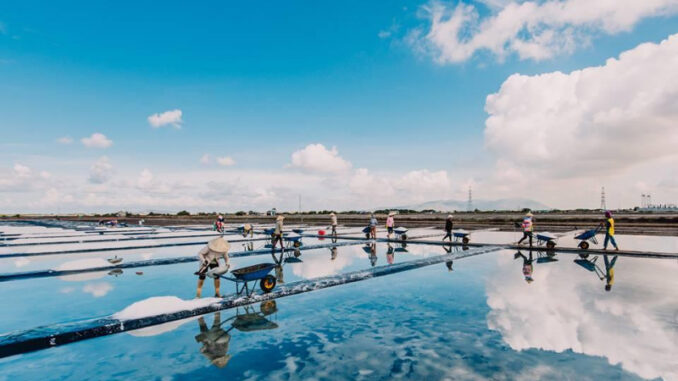
Nature has endowed Vietnam with a terrain of gold and silver forests with most of the country’s territory bordering the sea. The countryside of Vietnam is not only brilliantly beautiful because of the golden rice fields in the harvest season or the images of the blue sea, white sand, and sunshine that have gone deep into the subconscious but flickered somewhere, in the coastal areas, people We are also mesmerized by the salt fields crystallized from the pearl of the sea, by the sincere salt people, who have been flooded for many generations with the work of rain and birth. Let’s admire these beautiful salt fields.
Ca Na (Ninh Thuan)
Ca Na is located in Thuan Nam district, bordering Ninh Thuan and Binh Thuan, about 30km south of Phan Rang city. This place is considered the largest salt warehouse in the country with an area of up to 1,000 hectares of salt fields spread along the coast. It brings a sense of peace with the image of simple, rustic farmers, working hard day by day in the salt fields. Due to extremely favorable weather conditions, not only salt-making industry develops, but other tourism and service industries are also very active. It is known that with more than a thousand hectares of salt fields stretching along the coast, Ca Na is famous as the largest “salt warehouse” in the country.
The coast of Ninh Thuan is 105 km long with lots of sunshine and wind, giving it a rich but pure taste of salt, which is the raw material for making delicious Ca Na fish sauce. The salt-making season starts from about December to the end of August of the lunar calendar, coinciding with the time of the annual dry season. Since about 2017, salt farmers have been making salt to make salt on tarpaulin fields instead of the ground. Therefore, the salt crystallizes longer, so the quality is better. The product gives clean, beautiful white seeds, fewer impurities, and minimizes the impact on the environment. Based on the rocks on the shore, people make salt fields up to tens of hectares wide each. Ca Na salt is considered by experts to be the best salt in Southeast Asia. In addition, Ca Na is also an ideal tourist destination with many pristine beaches, clear blue, charming scenery…
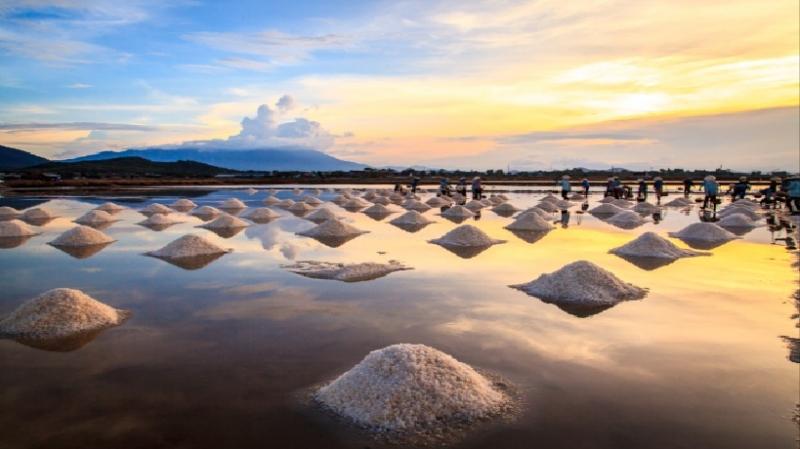
Phuong Cuu (Ninh Thuan)
Phuong Cuu salt field is about 15km from Phan Rang – Thap Cham city, in Phuong Hai commune, Ninh Hai district, Ninh Thuan province, considered the largest salt field in the Central region. Salt-making season starts around December to May of the following year. Coming here, visitors will discover new experiences and understanding about the lives of the salt people; capture the wonderful, shimmering, fanciful, and ravishing moments of the salt fields in the sunrise or sunset. At different times of the day, visitors seem to feel the beauty of the salt fields from different angles.
Coming here, visitors will admire the lively scene that combines the beauty of the natural landscape with the beauty of hard work. Seeing the salt-making stages for the first time, visitors will be surprised with the difficulty that the salt people have to go through to create the pure white salt grains that are used every day. A day of the salt making of the people of the salt fields begins early in the morning. The first step is to prepare the soil, soak the sand with sea water, then bring the sand evenly, dry it on the field and sprinkle seawater on the drying yard, sprinkle with salt bait. When the sand dries, on each grain of sand will crystallize each small grain of salt. The sunnier it is, the faster the salt will take shape, the scorching sun is the favor of God so that the crop can be bountiful so that the grains of salt are whiter and purer.
In the vast scenery of the sea, in the murmur of waves, the image of salt people in Phuong Cuu salt field is very small, but in them, one feels an overflowing vitality, a spirit of reaching out. up intensely. On those thin shoulders are the products of heaven and earth, the grains of salt created by them will become an indispensable spice in daily life. In the distinct beauty of the salt field, there are many touching things about the hard work of people to bring simple grains of salt, but make life saltier…
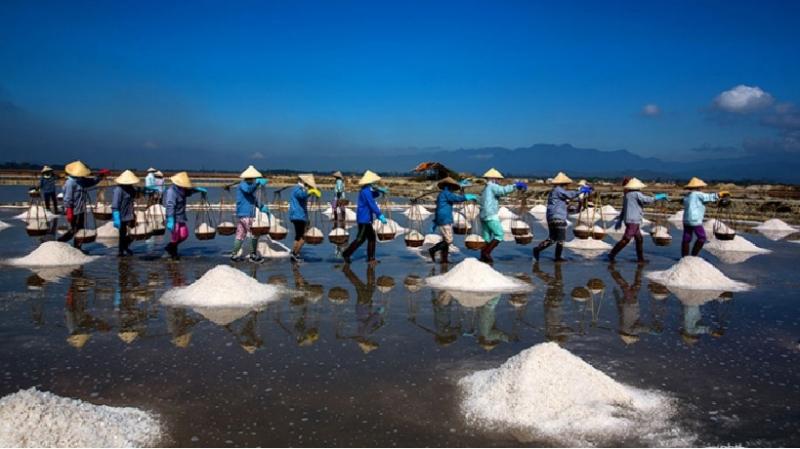
Hai Hau (Nam Dinh)
Hai Hau salt field is located in Van Ly village, Hai Ly commune, Hai Hau district, about 100km from Hanoi. If departing from Hanoi, visitors can choose to go by motorbike in the early morning or by car, which takes more than 2 hours. Coming here, you will feel the hard work of the people “one sun and two dew” who work hard to make white salt. To create salt grains, they have to go through many different processes such as: digging trenches, leading water, drying, harrowing… Hai Hau is a coastal district in Nam Dinh province. This place has a long tradition of making salt. A working day of salt-making people starts very early. The first is the sand soaking stage, the sand is soaked with seawater on the pre-made fields, then they water the seawater and sprinkle it with salt bait. Having to wait until noon, when the harsh rays of the sun crystallize each grain of salt on the grains of sand, people begin to scratch into small, white piles. One after another in a row in the middle of the burning sun, many drops of sweat fell. Towards the end of the afternoon, the bare feet carried the piles of salt back to the gathering place and ended a working day.
They kept busy with that work until sunset, when the sun glimmered through the casuarina tops, if once met the image of farmers in the salt field still busy working at the end of the day, You will feel some respect for them. Suddenly thinking about, in the midst of the immense scenery of the vast sea, with the sound of the waves, and seeing the image of salt people in the Hai Hau salt field, blending in with nature, you will become infinitely small. in the end, but in them, we still feel an overflowing vitality, and a strong rising spirit to infinity. If there was once an Hai Hau, especially in the sweltering heat of the summer weather left over after a long day when the sunset gradually falls over the salt fields, it will create an enchanting picture of nature, where there is a faint taste of hard work. but peaceful. And I believe that the salt field makes you unforgettable…
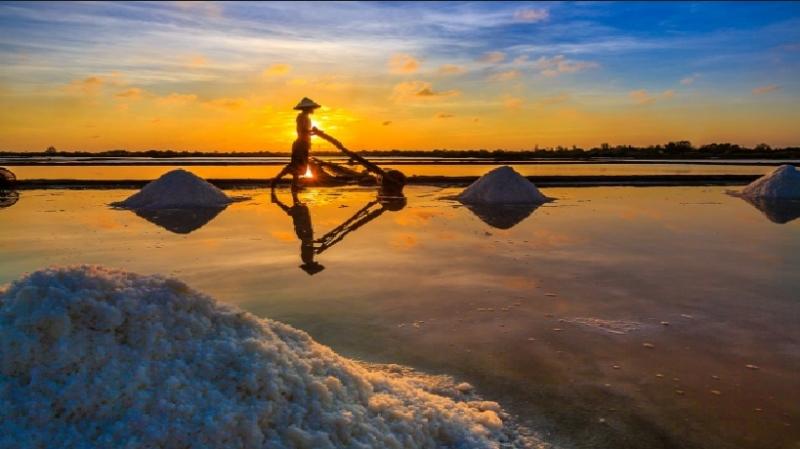
Diem Dien (Thai Binh)
Thai Binh is a fertile alluvial Red River Delta, which is not only known for the largest rice granaries in the country but also people are very attached to salt making for a long time. Diem Dien is located in Thai Thuy district, Thai Binh province. The salt-making season lasts from April to July, at this time, the strong wind combined with the hot sun creates the largest, boldest and strongest salt particles. Go to Diem DienIn addition to admiring the high salt ridges when sunset falls, visitors can also travel to Thuy Truong mangrove forest, An Co communal house and enjoy special dishes such as fish sauce, sour jellyfish, etc. 110 km southeast of Hanoi capital, Diem Dien town in Thai Thuy district, Thai Binh province is one of the three largest biosphere reserves of the Red River Delta. In the Sino-Vietnamese sense, the match is salt, Dien is a field, the original meaning of the word Diem Dien means salt field. The name of the village speaks of the profession of the people here, which is making salt and going to the sea. Diem Dien
Beach with the standard salt concentration of seawater to make white salt particles. The traditional village of sea salt making here has existed for a long time. Salt making lasts from about April to July of the year. Especially in April and June when the strong winds blow, and the hot yellow sun is the most favorable time to make the largest, boldest and strongest white salt grains. A day of the salt making of the people of Diem Dien begins early in the morning. The first step is to prepare the ground. People soak the sand with seawater, then bring the sand evenly, dry it on the land and sprinkle seawater on the drying yard, sprinkle with salt bait. When the sand dries, each grain of sand will crystallize each small grain of salt.
Under the hot summer sun, on each field of “growing” salt, the people bask in the scorching sun to get the fruits of their hard work. They are glad to be able to work in that burning sun, because the crop will be bountiful, the grains of salt will be whiter. On the contrary, if there is a sudden rain that seems to be in vain, the farmer has to start the process again from the beginning. Around 2 p.m. every day, salt begins to crystallize in the fields, and farmers rush to harvest salt. The salt is collected into pure white mounds reflecting on the field surface creating a unique picture. Each mound of salt was brought ashore to evaporate all the steam and packed into bags. It is so hard, but the people in the coastal areas are still diligent with their jobs. Once you come and feel, you will appreciate the salty grains of sea salt and love the people working in the white salt fields. SeaDiem Dien is also famous for its delicious fish sauce. Thai Thuy people often invite guests to visit their house with regional specialties such as snail salad, sour jellyfish, jellyfish salad, ron soup…
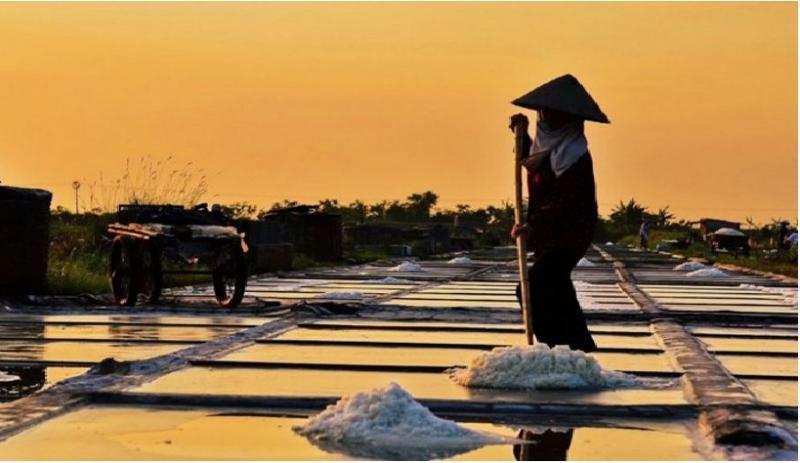
Sa Huynh (Quang Ngai)
Sa Huynh salt field in Duc Pho district, Quang Ngai province, invested in building 6 dike lines stretching 5 km. People are always busy working from March to August, creating a large amount of salt in the central region. Recently, they have changed the method of salt making, no longer making salt on the ground, but instead lining with canvas or cement, the quality of salt and the price are constantly improving. Sa Huynh salt field covers an area of more than 110ha, 60km from Quang Ngai city to the southernmost point of the province. The salt industry here has long become the livelihood of about 600 households and preserves many cultural beauties in the labor and production of the craft village.
In the early days of summer, when the sea is clear and sunny, the Sa Huynh salt field is white and one color. Coming here, visitors will hear stories of the sun and rain, the process of making salt, feel the salty taste of the sea, the salty taste of the sweat of the salt people pouring into the fields… According to historians, Sa Huynh salt fields have from the nineteenth century. After nearly 100 years, the salt-making method of the Sa Huynh people still keeps the tradition as it was in the beginning. From the 3rd lunar month when the sea waves are calm, the water is clear again, the tides rise and fall periodically, it is also the time when farmers go to the fields to make salt. After making the fields flat, from 5 a.m., salt people were present in the fields to carry out salt-making processes. Based on the rising tide, salt farmers bring water from canals and ditches into the water tank and then gently release it into the field. After the water is evenly coated on the small fields, wait for the sun to rise so that the saltwater gradually crystallizes into salt. In order for the salt to be white, large, and iridescent in the afternoon sun, salt farmers must keep the water for three days and when the salt fields are dry, they will be harvested.
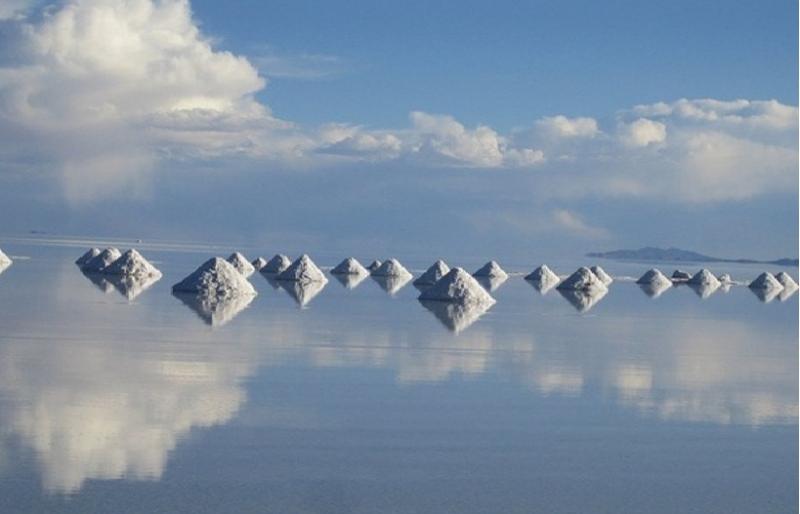
Hon Khoi (Khanh Hoa)
Not only exploiting the potential of sea tourism, but Khanh Hoa also knows how to make the most of the benefits from the sea. Salt-making villages were formed and developed constantly. Hon Khoi white salt field is located in the north of Khanh Hoa province, beautiful sparkling by Van Phong bay. The salt makers here are mainly women. They are fully equipped such as rubber gloves and boots to avoid exposure to excessive concentrations of salt. Coming to Khanh Hoa, you should visit this place to have a better experience for the journey. Hon Khoi is considered an attractive tourist destination with pure white salt fields, creating a unique beauty for this coastal land.
You can visit the salt fields here from December to April every year. At different times of the day, you can feel the beauty of the salt fields from different angles. Each mound of salt emerging in the middle of the white space is a source of photographic inspiration for tourists with romantic souls. You will be surprised because there is a beautiful sunrise rising up in the sun, below are salt fields stretching undulating, looking from afar, it looks like small mountain peaks covered with white snow. smooth. In the afternoon, when the sunset begins to fall, the scene becomes even more charming. At a certain time of the day, when the salt field is flooded with seawater, this is like a giant natural mirror, reflecting the sunset image of egg color or natural purple-pink on the ground. Visitors will no longer seem to be able to distinguish which is earth and which is heaven. The gentle rays of sunlight at the end of the day rolling on the water make you feel at peace amidst this bustling modern life.
When the salt fields have dried up and become natural “mountains” of salt, the sunset has a different nuance on the salt fields. Seen at low altitude, the image of the sun appears to be hidden among these miniature salt “mountains”, sometimes strongly exposed, sometimes hidden behind the mountains. The whole space is a peaceful beauty that helps visitors enjoy relaxing and deep moments with nature.
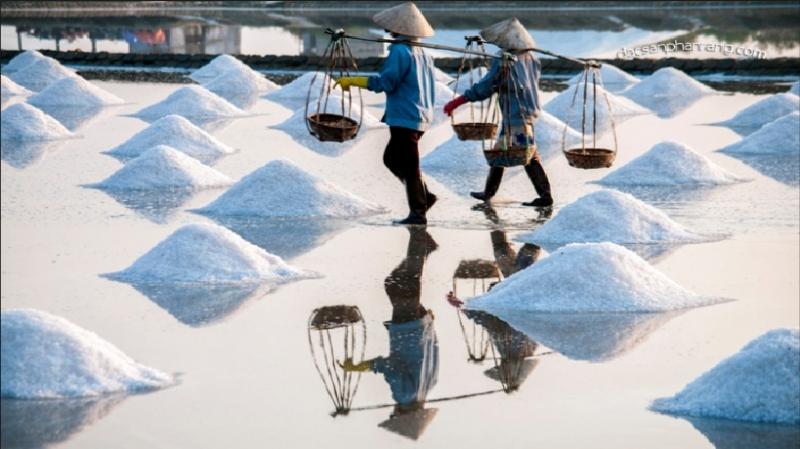
Ba Tri (Ben Tre)
The way to make salt in Ba Tri district, Ben Tre province is more unique than salt fields in other places. Here, the salt field is located deep inside the dyke, people use the soil to make the surface of the field. After about 2-3 days of drying in the open air, the new salt is collected in the warehouse for cleaning. Seen from afar, it is no different from the rainy season rice fields, beautiful shimmering, silhouetted against the sky. Under brilliant sunshine, pretty small salt particles in a field Three Tr i shone sparkling colors, looks away as the crystallized pearl from the salty sea.
Bao Thuan commune is one of four coastal communes of Ba Tri district, Ben Tre province. Although it is a coastal commune, all salt fields of the people are located deep within the dyke. Therefore, salt people here have to get seawater through the system of canals in the field. Salt making is one of the traditional occupations in Bao Thuan that has been preserved for a long time. Until now, the production of salt is still in the manual form of drying seawater until it crystallizes. Under the golden sunlight is the sparkling beauty of the white salt field, glistening with water. This place has attracted people who like to experience and many photographers find and record beautiful images of the salt industry.
Because of the low salinity of seawater, the salt productivity here is lower than in other sea areas such as Ca Mau, Nha Trang, Thai Binh… To get salty grains, people have to sweat a lot. the effort, basking in the blazing sun of heaven and earth. Under the harsh sun, the sparkling salt becomes more and more attractive, not only the joy of the salt people when they are in season… Coming to Bao Thuan, you will have the opportunity to experience the work of the profession together with the people. salt to appreciate the pure white salt and better understand the hard work of the people here.
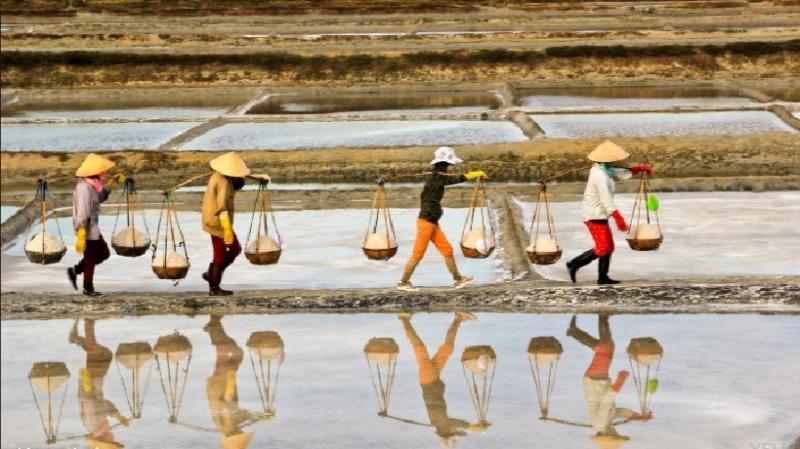
Long Dien (Vung Tau)
If you have the opportunity to go to Long Hai beach, follow provincial road 44A to Long Dien district to see firsthand the salt fields stretching far away. The shadow of a small villager next to a towering salt mound. The wheelbarrows quietly followed each other to transport salt until the afternoon gradually fell. The hot sun made sweat-drenched everyone’s backs, but everyone wished for the sun. That way, the salt will quickly form, if it rains, it’s like a lot of effort leaving the river and the sea. Then we see the hard work of the salt people. Visiting the Cho Ben salt field in An Ngai commune, Long Dien District, Ba Ria – Vung Tau province, you will be immersed in the salty breeze of the sea, endlessly following the white fields to your feet. heaven and marvel at the tenacity and endurance of the salt people.
For a long time, the coastal city of Vung Tau is not only brilliantly beautiful by the image of the blue sea, white sand, and sunshine, but somewhere, people are also fascinated by the salt field crystallized from the pearl of the sea. by the honest people, who have flooded for many generations with the work of the rain and birth. Located between majestic mountains, rolling clouds in the blue sky, ardent laborers forgetting fatigue… is a colorful picture of the salt-making work of salt farmers in the salt field. Ben, Long Dien.
To get here, from Ba Ria along provincial road 44A to Long Hai beach, you will be able to see firsthand a wild, vast salt field stretching to the horizon. As a child of the sea, besides their thousand-year-old career floating on the waves, in the period from December this year to May next year, they are busy working in salt production to find more income. . Because only those who have once set foot on that land can see the rustic, idyllic beauty that is so attractive. There is nothing more beautiful than seeing the salt fields under the harsh sunlight of the sun. At different times of the day, people seem to feel the beauty of the salt fields in different lyrical and nostalgic angles.
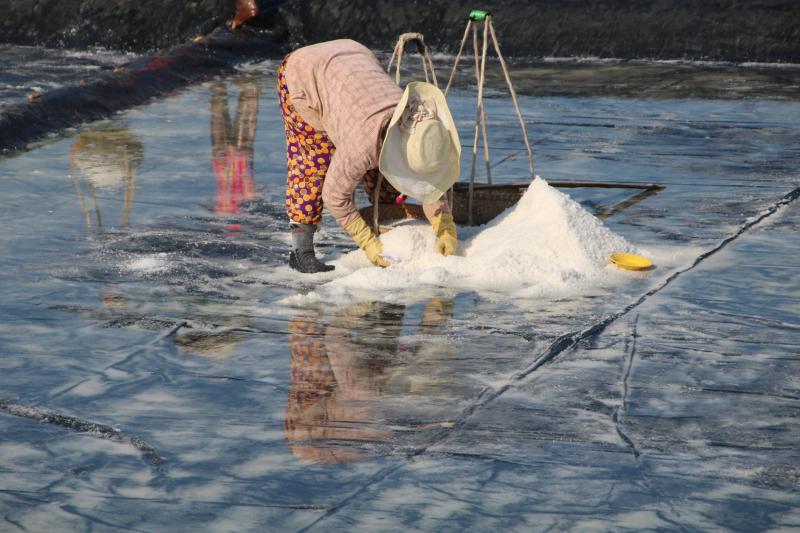
Bach Long Salt Field
As one of the largest salt granaries of the North with an area of up to 230 ha of salt production, Bach Long salt field (Bach Long commune, Giao Thuy) is famous for its long-developed salt industry and beauty of the natural landscape. as well as the hard-working people here. This is also an interesting destination that you should visit on your Nam Dinh countryside tour. If in Central and South Vietnam salt is made by drying method, then salt in the North is made by drying sand method. And let’s come to Bach Long salt field You will have a very interesting and wonderful feeling when learning about the ancient salt villages with this method. This salt flat area has long been a land accreted by the beach after many years, people from all over the world moved to live, set up villages and communes since the French colonial period. rich and crowded. Because it is a coastal area, Bach Long does not grow wet rice like other rural areas in Vietnam. Instead, with abundant saltwater, the salt industry has developed here for hundreds of years.
It is not only beautiful because of the tradition and people with the salt industry, but also because of the beautiful, close, sunny and windy natural scenery of the coastal countryside, suitable for enjoying the fresh air and taking pictures. gorgeous summer. The image of salt fields, salt carts, white salt boats along with the image of the salty children of the sea who are industrious and enthusiastic with the fruits of their labor always impress each and every one of us when coming here. We appreciate the people as well as more than every grain of salt that we eat every day. In Nam Dinh, there are many craft villages and localities with unique traditions, giving income and creating a cultural identity for the region. Especially in Bach Long here, salt is considered a symbol of the source of life, an indispensable thing.
Next to the salt village; During the eco-tour here you can also visit the beautiful beaches here, go to the afternoon fish market right on the coast after fishermen catch a long day, .. bustling scene of buying and selling of fish. fresh seafood at a very cheap price, visit the homes of the simple and open people here to experience a relaxing day with the countryside,… Bach Long salt field It is also very popular with tourists inside and outside the province. Professional photographers also regularly visit this place to be able to capture great moments that exude the beauty of nature and working people. This place also appeared many times on television with the programs S Vietnam, Vietnam discovery,…And the last thing, a hundred hearing is not equal to one seeing. If you are impressed with the beauty of nature and people here, what are you waiting for, pack your bags and go back to Nam Dinh right away…
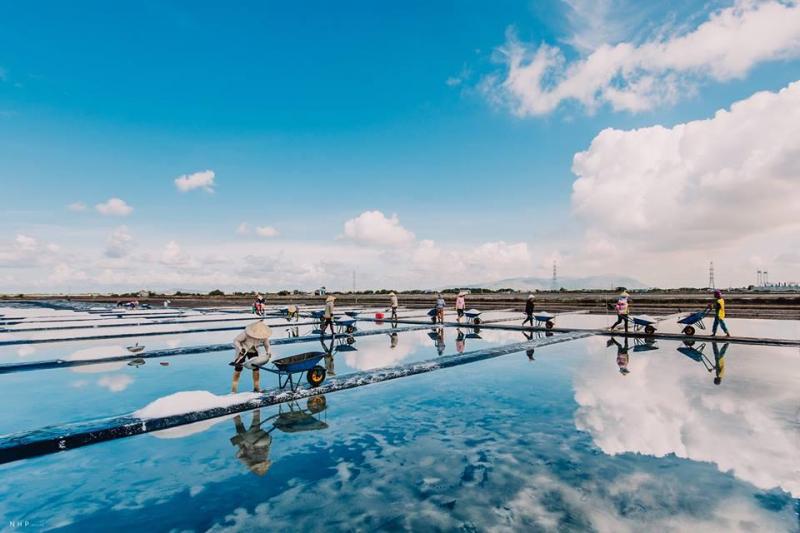
Bac Lieu salt field
Bac Lieu is a province on the coast of the Mekong Delta, located on the Ca Mau peninsula, the southernmost land of Vietnam. In Bac Lieu, there are two districts with long-standing attachment to salt making, namely Hoa Binh and Dong Hai. Salt in Bac LieuSince ancient times, it has been famous throughout the Southern region for its rich, unique, and very distinct flavor. Not only that, with the vast salt fields, covered with pure white color, it has created a beautiful scene that attracts a large number of tourists coming here every year. The first impression when coming here is the poetic, fresh scenery, the vast and immense salt field is covered by the pure white of tiny salt particles. When the sun shines on, the salt field becomes sparkling, sparkling beautifully. Salt fields are divided into small squares, straight and very eye-catching, surrounded by deep blue beaches stretching. When the salt is harvested, it will be lumped into different big and small piles, seen from a distance like diamonds undulating in the middle of the field. Not only the beautiful scenery, the scene of the people here working hard,
Coming here, visitors can comfortably “live virtual”, save beautiful photos with friends and relatives without paying entrance fees. To visit the Bac Lieu salt field , visitors should choose the right time, when the weather is dry and sunny. Ideally, visitors should visit Bac Lieu salt fields from December to May because this is the beginning of the harvest season. In this season, the salt field becomes busier and more joyful. People are always present in the field busy harvesting salt. Visiting the salt fields and observing the people here working, visitors will appreciate and cherish the white salt grains more. The people here, day by day with double light burdens are still diligently making salt grains, salty salt burdens with the unique flavor of the sea. The images of people attached to the salt industry have contributed to the unique beauty of this dear land.
Visitors should come here in the morning or evening to catch the best views of the salt fields. And especially you should avoid coming at noon because this is the time when the sun is hot, the water is evaporating to form salt, so it will be very hot and muggy. At sunrise and sunset, the salt field is very beautiful. All the natural scenery blends together, the deep blue of the sky, the pure white of salt, far away from the wild color of the mountains and forests, plus the sunshine is enough to make everything magical and poetic. dream. A salt field is an ideal place, suitable for tourists who like to experience the sun and wind. Coming here, visitors are not only immersed in the charming scenery but also know more about the process of making salt “the quintessence of heaven and earth”, the hard work and diligence of the farmers.. .
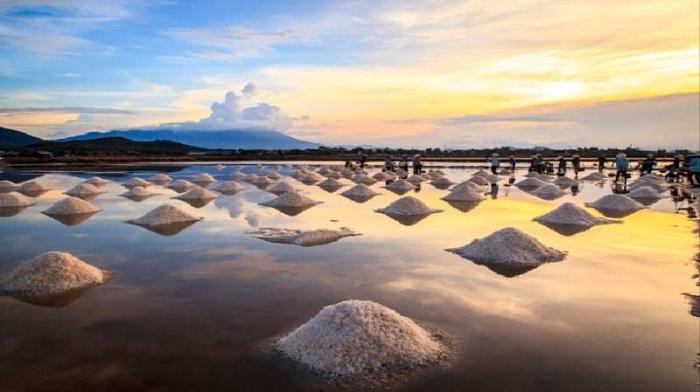
The salt fields are really attractive, aren’t they? If you have the opportunity to visit these provinces, please visit them. You will get great photos.
